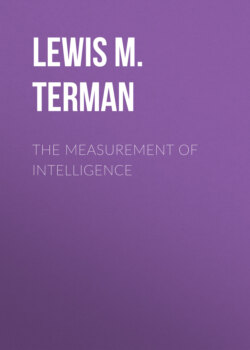Читать книгу The Measurement of Intelligence - Lewis M. Terman - Страница 18
На сайте Литреса книга снята с продажи.
The intelligence of retarded children usually overestimated.
ОглавлениеTable of Contents
One of the most common errors made by the teacher is to overestimate the intelligence of the over-age pupil. This is because she fails to take account of age differences and estimates intelligence on the basis of the child’s school performance in the grade where he happens to be located. She tends to overlook the fact that quality of school work is no index of intelligence unless age is taken into account. The question should be, not, “Is this child doing his school work well?” but rather, “In what school grade should a child of this age be able to do satisfactory work?” A high-grade imbecile may do average work in the first grade, and a high-grade moron average work in the third or fourth grade, provided only they are sufficiently over-age for the grade in question.
Our experience in testing children for segregation in special classes has time and again brought this fallacy of teachers to our attention. We have often found one or more feeble-minded children in a class after the teacher had confidently asserted that there was not a single exceptionally dull child present. In every case where there has been opportunity to follow the later school progress of such a child the validity of the intelligence test has been fully confirmed.
The following are typical examples of the neglect of teachers to take the age factor into account when estimating the intelligence of the over-age child:—
A. R. Girl, age 11; in low second grade. She was able to do the work of this grade, not well, but passably. The teacher’s judgment as to this child’s intelligence was “dull but not defective.” What the teacher overlooked was the fact that she had judged the child by a 7-year standard, and that, instead of only being able to do the work of the second grade indifferently, a child of this age should have been equal to the work of the fifth grade. In reality, A. R. is definitely feeble-minded. Although she is from a home of average culture, is 11 years old, and has attended school five years, she has barely the intelligence of the average child of six years.
D. C. Boy, age 17; in fifth grade. His teacher knew that he was dull, but had not thought of him as belonging to the class of feeble-minded. She had judged this boy by the 11-year standard and had perhaps been further misled by his normal appearance and exceptionally satisfactory behavior. The Binet test quickly showed that he had a mental level of approximately 9 years. There is little probability that his comprehension will ever surpass that of the average 10-year-old.
R. A. Boy, age 17; mental age 11; sixth grade; school work “nearly average”; teacher’s estimate of intelligence “average.” Test plainly shows this child to be a high-grade moron, or border-liner at best. Had attended school regularly 11 years and had made 6 grades. Teacher had compared child with his 12-year-old classmates.
H. A. Boy, age 14; mental age 9–6; low fourth grade; school work “inferior”; teacher’s estimate of intelligence “average.” The teacher blamed the inferior quality of school work to “bad home environment.” As a matter of fact, the boy’s father is feeble-minded and the normality of the mother is questionable. An older brother is in a reform school. We are perfectly safe in predicting that this boy will not complete the eighth grade even if he attends school till he is 21 years of age.
F. I. Boy, age 12–11; mental age 9–4; third grade; school work “average”; teacher’s estimate of intelligence “average”; social environment “average”; health good and attendance regular. Intelligence and school success are what we should expect of an average 9-year-old.
D. A. Boy, age 12; mental age 9–2; third grade; school work “inferior”; teacher’s estimate of intelligence “average.” Teacher imputes inferior school work to “absence from school and lack of interest in books”; we have yet to find a child with a mental age 25 per cent below chronological age who was particularly interested in books or enthusiastic about school.
C. U. Girl, age 10; mental age 7–8; second grade; school work “average”; teacher’s estimate of intelligence “average.” Teacher blames adenoids and bad teeth for retardation. No doubt of child’s mental deficiency.
P. I. Girl, age 8–10; mental age 6–7; has been in first grade 2½ years; school work “average”; teacher’s estimate of intelligence “average.” The mother and one brother of this girl are both feeble-minded.
H. O. Girl, age 7–10; mental age 5–2; first grade for 2 years; school work “inferior”; teacher’s estimate of intelligence “average.” The teacher nevertheless adds, “This child is not normal, but her ability to respond to drill shows that she has intelligence.” It is of course true that even feeble-minded children of 5-year intelligence are able to profit a little from drill. Their weakness comes to light in their inability to perform higher types of mental activity.
